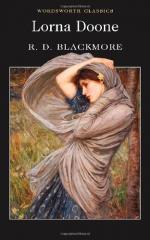Now the wisest person in all our parts was reckoned to be a certain wise woman, well known all over Exmoor by the name of Mother Melldrum. Her real name was Maple Durham, as I learned long afterwards; and she came of an ancient family, but neither of Devon nor Somerset. Nevertheless she was quite at home with our proper modes of divination; and knowing that we liked them best—as each man does his own religion—she would always practise them for the people of the country. And all the while, she would let us know that she kept a higher and nobler mode for those who looked down upon this one, not having been bred and born to it.
[Illustration: 142.jpg Mother Melldrum]
Mother Melldrum had two houses, or rather she had none at all, but two homes wherein to find her, according to the time of year. In summer she lived in a pleasant cave, facing the cool side of the hill, far inland near Hawkridge and close above Tarr-steps, a wonderful crossing of Barle river, made (as everybody knows) by Satan, for a wager. But throughout the winter, she found sea-air agreeable, and a place where things could be had on credit, and more occasion of talking. Not but what she could have credit (for every one was afraid of her) in the neighbourhood of Tarr-steps; only there was no one handy owning things worth taking.
Therefore, at the fall of the leaf, when the woods grew damp and irksome, the wise woman always set her face to the warmer cliffs of the Channel; where shelter was, and dry fern bedding, and folk to be seen in the distance, from a bank upon which the sun shone. And there, as I knew from our John Fry (who had been to her about rheumatism, and sheep possessed with an evil spirit, and warts on the hand of his son, young John), any one who chose might find her, towards the close of a winter day, gathering sticks and brown fern for fuel, and talking to herself the while, in a hollow stretch behind the cliffs; which foreigners, who come and go without seeing much of Exmoor, have called the Valley of Rocks.
[Illustration: 143.jpg Tarr-Steps]
This valley, or goyal, as we term it, being small for a valley, lies to the west of Linton, about a mile from the town perhaps, and away towards Ley Manor. Our homefolk always call it the Danes, or the Denes, which is no more, they tell me, than a hollow place, even as the word “den” is. However, let that pass, for I know very little about it; but the place itself is a pretty one, though nothing to frighten anybody, unless he hath lived in a gallipot. It is a green rough-sided hollow, bending at the middle, touched with stone at either crest, and dotted here and there with slabs in and out the brambles. On the right hand is an upward crag, called by some the Castle, easy enough to scale, and giving great view of the Channel. Facing this, from the inland side and the elbow of the valley, a queer old pile of rock arises, bold behind one another, and quite enough to affright a man, if it only were ten times larger. This is called the Devil’s Cheese-ring, or the Devil’s Cheese-knife, which mean the same thing, as our fathers were used to eat their cheese from a scoop; and perhaps in old time the upmost rock (which has fallen away since I knew it) was like to such an implement, if Satan eat cheese untoasted.




